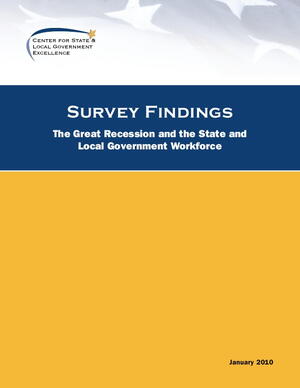
States and local governments also have made significant changes in their benefit offerings.
Changes in health and retirement plans
Half of the respondents, human resources professionals, report that their governments have made changes to their health care plans:
- Increased employee contributions (69 percent)
- Added number of years required to vest (25 percent)
- Added wellness programs, 24-hour nurse lines, or on-site clinics (25 percent)
- Reduced benefits (23 percent)
- Tiered benefits (15 percent)
- Decreased employer contributions (10 percent)
Survey respondents
The survey was conducted among members of two groups of government professionals: the International Public Management Association for Human Resources (IPMA-HR), and the National Association of State Personnel Executives (NASPE). Of the members who responded to the electronic questionnaire, 78 percent work for local government; 14 percent for state government; 3 percent for federal government; and 5.4 percent for a non-government sector. Some questions elicited more responses than others.
Critical positions go unfilled
There are signs that governments need a more strategic approach to their talent challenges. Survey respondents said they are struggling to fill certain critical positions, including jobs in engineering, skilled trades, information technology, health care, finance, law enforcement, and top management.
Furloughs don't always equal savings
Even furloughs have not produced the savings that had been anticipated in some places. While 61 percent of respondents say that they achieved the savings that had been budgeted, 39 percent said they did not.
Fiscal constraints and talent challenges
"Local and state governments face fiscal constraints for at least two more years, but they also face major talent challenges,” said Elizabeth K. Kellar, president and CEO, Center for State and Local Government Excellence. “They must tighten their belts while keeping an eye on their aging workforce. Making sure they have the right people in place to provide critical services is just as important as balancing the budget.”
The economic downturn has affected retirement plans, giving governments a little breathing room. Almost half (46 percent) of the survey’s respondents report that retirement-eligible employees are postponing their retirements.“The survey results highlight the short- and longer-term challenges facing governments,” said Neil E. Reichenberg, executive director of IPMA-HR.” In the short term, governments need to make sure that they are dealing effectively with the economic downturn, which has required many employers to make painful decisions that have impacted their most important asset – their employees. Governments need to focus on workforce and succession planning so that they can address their talent needs when the economic recovery takes hold.”"It’s key that governments utilize workforce plans that consider future talent needs when they are making these difficult staffing decisions forced by the significant fiscal constraints they’re experiencing,” added Leslie Scott, director of NASPE. “Our member states have noted that for the limited hiring that the states are currently doing, the applicant quality is higher and it’s providing an opportunity to hire talented managers who may not have previously considered working for state government.”